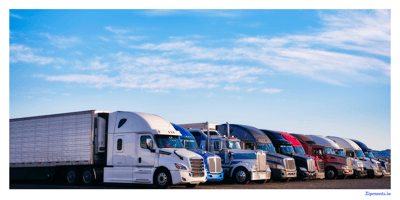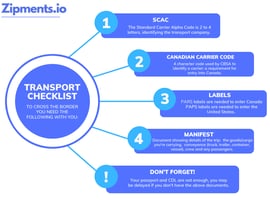The United State’s relationship with Canada is an important one. The two nations do business...
Cross-Border Transport: U.S. Entry Rules for Drivers
Trucking is a tough job. It's not for the weak at heart, but it can also be one of the most rewarding careers around. Cross-border trucking, however, presents its own set of challenges and opportunities. Canada and the United States share a boundary that is the longest international border in the world. When it comes to goods, commerce, and trade, both countries are deeply linked. This means that there has been a steady flow of cross-border trucking for years. However, in order to enter the U.S. as a truck driver, it is important to ensure all guidelines are followed, as the country is strict with its rules for entry.
.png?width=6912&name=Green%20Gold%20Contemporary%20%26%20Classy%20Traditional%20Graduation%20Classy%20Banner%20(3).png)
When driving commercial goods cross-border into the United States, aside from your documents such as your passport and driver's license, you need to consider these key driver rules and regulations:
1. Admissibility
It’s more than just the goods you are transporting, which are subject to customs checks, but the driver also needs to make sure they are allowed into the country they are transporting to. For Canada - U.S. transport, there are specific guidelines that need to be met, and being aware of them can help make the process easier. To be admissible to the United States you can be a foreign driver so long as you quality under the B-1 policy for business visitors. You can read more detail about the Immigration and Nationality Act of 1952 on the CBP website. However, the basics of these entry requirements are:
- Having residence in a foreign country that you do not wish to abandon
- Intent to leave the US after authorized period ends
- Having the financial means to carry out your purpose of the visit in the US
- Establish you are not inadmissible due to violating some of the guidelines such as criminal, health related, improper manner of arrival or other categories
Make sure not to lie about any information which may be on record. If you say no to the question of have you ever been arrested, and the records show you have, you may be sent back. If you do have a criminal record, you may apply for a pardon beforehand, as this will increase your odds of trucking cross-border successfully. The criminal record search is also part of the FAST (Free and Secure Trade) card application. Answer truthfully, because it can be difficult to come back into the country, if you have been denied once. CBP keeps a record of these matters.
2. International Carrier Bond
In order to transport freight into the US, you need to get certified with the CBP with an international carrier bond. This bond on file will allow you to carry your freight across the border. You may also file for the bond at the port of entry/exit you use most often in your transportation journey.
3. SCAC Code
In order to identify the transportation company or carrier to the CBP or customs, you need a SCAC code on file. This code is a requirement when dealing with a government agency, meaning the US Customs and Border Protection (CBP). This helps customs recognize that you are transporting legally into the United States. You can obtain a code from the National Motor Freight Traffic Association, NMFTA.
4. You cannot interstate
Another rule in cross-border trucking is that a foreign driver cannot drop off a load in the US and then go pick up and drive other domestic freight, between states. This is known as interstating, and it is not allowed. Specifically, activity which is not allowed under this rule is:
- Picking up freight at one US location and delivering it to another US location
- Repositioning an empty trailer between 2 points in the US, when the driver did not depart or enter US with that same trailer
- Picking up additional domestic freight to fill up the empty space in your trailer with your international shipment
- Soliciting return loads while in the US
You can, however, do certain things while in the country, so long as you adhere to the guidelines. Here is the rundown of things which are allowed:
- A driver can enter with an empty tractor to pick up a trailer meant for delivery and take it back to Canada.
- A driver can also enter with an empty tractor to pick up a loaded trailer which was previously brought from Canada and left at port of entry or customs warehouse awaiting inspection. This would not apply for goods which have already cleared inspection.
- A driver can drop a trailer off at one location in the US, and drive empty to another location to pick up a trailer meant for Canada.
- A driver can perform functions necessary to the international trade, such as loading and unloading that is somehow incidental to the primary purpose which is transporting goods.
Word of Advice: Though not an entry rule, remember that you must also adhere to United States HOS (Hours of Service) rules, when driving or operating within the United States. You can learn more about the HOS rules here.
If you violate the entry rules for drivers, you may be banned permanently or temporarily from operating within the US, and your cargo or equipment may be subject to seizure. If you are a business owner, you can employ a foreign driver for the purpose of international delivery of goods or cargo from or to the United States, but the driver cannot carry domestic goods within the US without authorization to work in the US.
Cross-border rules and any type of issues that you might have to face are easy to avoid, if you know what you need ahead of time. Truck driving is a demanding job and drivers face a lot of risk in order to complete the process safely. If you're going to be involved in international transport, that also means you have to abide by US laws—especially when it comes to transporting goods across borders. These simple rules will protect your time and your business venture.


.jpg?height=200&name=Red%20Blue%20Neon%20Technology%20Video%20(4).jpg)
